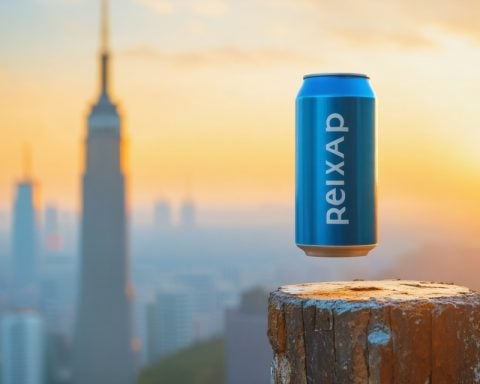The fashion giant Shein is gearing up for a stock market debut, raising eyebrows about its potential environmental impact. Experts suggest that this move could drive not just financial growth, but also an increase in their emissions footprint.
Dr. Pete Clark from UCL School of Management highlights a trend where companies going public often focus on expansion rather than sustainability. As Shein prepares for this flotation, activism against its practices intensifies, with groups like “Say No To Shein” advocating for greater responsibility from the company.
In response to these concerns, Shein is working on a detailed plan aimed at achieving net-zero emissions by 2050. A company spokesperson noted that the strategy will emphasize areas with the highest emissions, particularly focusing on purchased goods and logistics. They mentioned an ambitious near-term goal to reduce emissions across various scopes by 25% by 2030, a target that has received endorsement from the Science Based Targets initiative.
However, critics express skepticism over these initiatives, arguing they fall short without a fundamental change in Shein’s business model. Concern mounts regarding the company’s heavy reliance on virgin polyester, which constitutes about 75.7% of its materials. This choice is contentious due to its fossil fuel origins, despite claims that it may align with lower overall emissions in certain assessments.
As the IPO advances, the challenge remains: can Shein balance growth with genuine sustainability?
The Broader Implications of Shein’s IPO and Environmental Concerns
The impending IPO of Shein represents a pivotal moment not only for the brand but also for the global fashion industry. As Shein seeks to expand its market share, the implications of its actions extend beyond profit margins and consumer preferences, potentially altering societal norms surrounding fast fashion. Critics argue that increased financial power could exacerbate the already significant environmental impact associated with rapid clothing production, which contributes to vast amounts of waste and carbon emissions.
Shein’s reliance on virgin polyester raises pressing questions about sustainability in fashion. Globally, the textile industry accounts for approximately 10% of greenhouse gas emissions, and as more consumers engage with brands that prioritize low-cost, high-volume production, the urgency for meaningful change intensifies. The push for sustainability may not solely stem from corporate responsibility but could also be a response to shifting consumer values—particularly among younger generations who prioritize environmental stewardship.
As the world grapples with the effects of climate change, the fashion industry’s impact on ecosystems cannot be overstated. A continued focus on fossil fuel-derived materials threatens to undermine progress towards a circular economy. Looking ahead, future trends may hinge on transparency and social accountability; as brands like Shein navigate this critical juncture, they must weigh consumer demands against their operational models. The challenge remains: Will Shein and similar giants adjust their practices to reflect an evolving landscape where sustainability is paramount, or will they become emblematic of a broader reluctance to challenge the status quo?
Is Shein’s Move to Go Public a Double-Edged Sword for the Environment?
Introduction
As the fast-fashion retailer Shein prepares for its stock market debut, it raises significant discussions regarding its environmental impact and sustainability practices. The intersection of financial growth and ecological responsibility is under scrutiny, with concerns that Shein’s expansion could exacerbate its emissions footprint.
Current Sustainability Efforts and Goals
In light of rising scrutiny, Shein has unveiled plans to achieve net-zero emissions by 2050. This ambitious roadmap seeks to address primarily the areas of highest emissions, particularly focusing on purchased goods and logistics to optimize its operations. Furthermore, the company has set a near-term target to reduce emissions across various scopes by 25% by 2030. This goal has garnered support from the Science Based Targets initiative, indicating some level of commitment to environmental accountability.
Pros and Cons of Shein’s IPO
Pros:
– Potential for Financial Growth: A successful IPO could provide Shein with capital for investment in sustainability initiatives.
– Increased Public Awareness: The spotlight on Shein’s practices could pressure the company to adopt more responsible behaviors.
Cons:
– Sustainability Concerns: Critics argue that Shein’s current model, heavily reliant on virgin polyester, undermines its credibility in sustainability. Virgin polyester, which makes up about 75.7% of its materials, raises concerns due to its fossil fuel origins.
Activism and Public Perception
Activist groups like “Say No To Shein” are amplifying demands for greater transparency and responsibility from the retailer. The call for accountability is gaining traction, reflecting a broader consumer shift towards sustainability and ethical manufacturing practices. This activism poses a risk for Shein as public perception increasingly influences brand loyalty and consumer choices.
Innovations in Sustainable Fashion
The fast-fashion industry is experiencing innovations that emphasize sustainability, including:
– Recycled Materials: Many brands are exploring the use of recycled fabrics to minimize environmental impact.
– Supply Chain Transparency: Companies are adopting technologies like blockchain to enhance the transparency of their supply chains.
– Circular Economy Practices: Some fashion businesses are embracing recycling and resale strategies to prolong the lifecycle of garments.
Market Trends and Insights
The rapid rise of sustainability as a priority for consumers indicates a fundamental shift in buying habits. Reports suggest that brands actively pursuing sustainable practices are seeing a favorable response from their customer base, leading to increased sales and loyalty. This shift presents both a challenge and an opportunity for Shein as it navigates its public debut amidst growing environmental concerns.
Limitations of Current Strategies
Despite Shein’s plans, many critics argue that without a fundamental shift in the company’s business model, these initiatives may not yield the desired results. The reliance on fast fashion principles, characterized by frequent, low-cost offerings, significantly undermines efforts to achieve lasting sustainability.
Conclusion
As Shein gears up for its IPO, the critical question remains: can the company balance its growth ambitions with the imperatives of genuine sustainability? The path forward will require a significant reassessment of Shein’s operational model, consumer engagement strategies, and a commitment to true environmental responsibility.
For more discussions on sustainable fashion and corporate responsibility, visit Shein Fashion.












